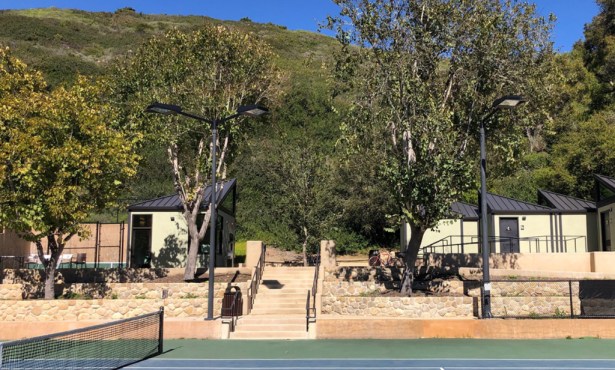No Buddha, No End of Buddhas
Buddha Abides
At Caruso Woods Fine Art, through June 17.
Reviewed by Beth Taylor-Schott
The first precept offered to lay order members by Buddhist
teacher Thich Nhat Hanh begins thus: “Aware of the suffering
created by fanaticism and intolerance, I am determined not to be
idolatrous about or bound to any doctrine, theory, or ideology,
even Buddhist ones.” The curators and artists of Buddha
Abides, now at Caruso Woods through June 17, seem to have
taken a similar artistic vow.
The show’s call for entries states that works “must reflect
Buddhist themes.” It turns out that they need not necessarily
include the figure of the Buddha himself. In “Buddha Abides” by
Sally Chiu, only the stenciled word “Buddha” emerges over and over
from a Rothko-esque background. A lush photograph by Chris Messner,
“Bamboo Forest,” depicts only the plant, a Zen symbol for Buddha
nature. “Wing and a Prayer” by Annette Matrisciano distorts, beyond
recognition, not just the Buddha, but the human figure as well.
More often the works do include a recognizable Buddha. At times,
this figure is one element in a larger collage or assemblage.
Rosemary’s “Bloom & Bless” arranges rose petals in concentric,
lotus-shaped circles, with a simple gold-stamped Buddha at the
center. “Buddha with Birds” by Marcelino Jimenez presents the
Buddha as part Baroque fancy, part St. Francis. Other works
represent the Buddha in entirely Western idioms. “New Moon Buddha”
by Linda Cassierer creates the Buddha out of patchwork, while in
“Buddha of the Southwest” by Bruce Birkland, the Buddha emerges as
an enormous striated stone figure, blending in with the mesas and
canyons around him.
The most successful works integrate Buddhist notions on the
deepest levels. “Me as Buddha,” a watercolor by Meganne Forbes,
asks us to see the Buddha as a beautiful, female nude, painted in
the manner of a monumental tarot card. “Bamboo Buddha,” by Blake
Lannon, offers a bamboo grove alive with shape and color as if at
the moment of awakening, an indistinct Buddha statue tucked into
the greenery.
The show even has room for a work that, except for its size and
mounting, could pass for a Tibetan thangka, or religious scroll
painting. But “Amitabha,” Buddha of Infinite Light, which takes
pride of place in the gallery window, was not painted by a
traditional artisan. It is the work of Tamarind Rossetti, a native
of Ojai, who created the work using a book written in Tibetan,
which she could not read, forcing her to depend entirely on its
diagrams. The Buddha taught that there are 84,000 dharma doors, or
paths to enlightenment. As this show makes clear, there are at
least as many ways of depicting them.


